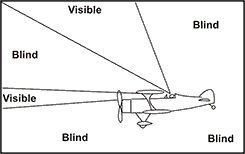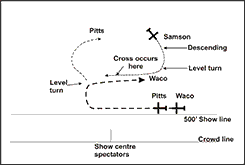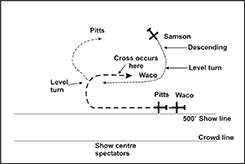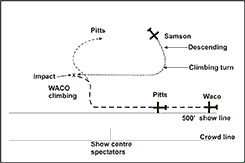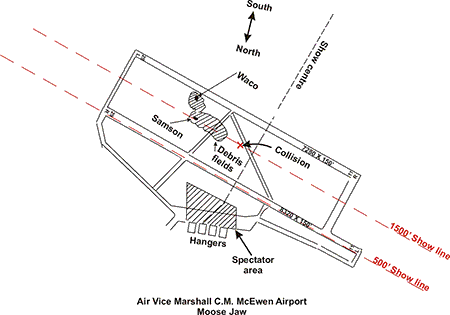In-Flight Collision
Between
Waco UPF-7 N2369Q and
Wolf-Samson N985PW
Moose Jaw, Saskatchewan
The Transportation Safety Board of Canada (TSB) investigated this occurrence for the purpose of advancing transportation safety. It is not the function of the Board to assign fault or determine civil or criminal liability. This report is not created for use in the context of legal, disciplinary or other proceedings. See Ownership and use of content. Masculine pronouns and position titles may be used to signify all genders to comply with the Canadian Transportation Accident Investigation and Safety Board Act (S.C. 1989, c. 3).
Summary
Three United States-registered aircraft were engaged in a simulated dogfighting display at Moose Jaw/Air Vice Marshal C.M. McEwen Airport as part of the Saskatchewan Air Show. The display team, called The Masters of Disaster, consisted of three biplane aircraft: a Waco UPF-7 (registration N2369Q, serial number 5387), a Wolf-Samson (registration N985PW, serial number WS001) and a Pitts Special (registration N99MF, serial number 3004). A ground display featuring a jet-powered truck called Shockwave was part of the act.
At approximately 1617 central standard time, the three biplanes were performing a series of crosses and chases in a simulated dogfight scenario. As the jet-powered truck moved into position on the 500-foot show line, the three biplanes entered a manoeuvre in preparation for a series of crosses centred on the truck. During the manoeuvre, the Waco and the Wolf-Samson collided near show centre at about the 1500-foot show line. Both biplanes caught fire and crashed between the 1500-foot show line and the outer runway. Both pilots were killed at impact, and both aircraft were destroyed. All debris fell away from the crowd toward the outer runway. Immediate implementation of emergency procedures kept spectators from moving toward the burning wreckage.
Factual information
The Display Team
The display team, the Masters of Disaster, was formed in 2002. In the display, three biplanes performed a series of simulated air combat manoeuvres, or dogfight. As the manoeuvres were performed, the biplanes would execute crosses that created the illusion of near collisions when viewed from the spectator area. The display incorporated a jet-powered truck, which was chased by the biplanes as it manoeuvred on the ground.
The crosses by the biplanes were planned to ensure safe separation. Safe separation was accomplished visually using a set of agreed rules. For each set of manoeuvres, the display pilots agreed to a "contract." In air show terminology a contract consists of an agreement between each pilot that establishes how each pilot will fly the manoeuvre and which pilot is responsible for establishing visual separation. A contract also includes an agreement about how to disengage from a manoeuvre that does not go as planned.
The Accident Aircraft
The Waco was originally manufactured in 1940 as a Waco model UPF-7, serial number 5387. The biplane was extensively modified and strengthened for displays. The biplane was powered by a Pratt & Whitney R-985 and a General Electric J-85 jet engine mounted underneath the fuselage. The cockpit had been moved aft along the fuselage from its original position.
The Wolf-Samson was manufactured as a replica of an original Wolf-Samson biplane and was registered in 1993. The biplane was powered by a Pratt & Whitney R-985 engine.
Both biplanes were highly manoeuvrable with ample power for the planned display. All aircraft have design limitations that restrict pilot visibility. Because the upper wing of biplanes is mounted ahead of and above the pilot, a significant additional blind spot is created in the pilot's field of vision (see Figure 1). The blind spot was reduced in the Waco because of the cockpit modification. However, because of the inherent manoeuvrability of the two aircraft, the display pilots could quickly move the nose or wings out of the way to locate the other performers. Additionally, the aircraft were equipped with smoke generators. The display pilots used the smoke to quickly acquire the position of other performers. Temporary loss of visual contact between performers is considered acceptable when manoeuvres are flown as scripted because the performers know when and where visual contact will be regained. Manoeuvres must be planned so this temporary loss of contact does not compromise safety.
Both biplanes were radio equipped. Radio use was limited during the display because the pilots found that the high noise level of the open cockpits made understanding transmissions unreliable.
International Council of Air Shows
The International Council of Air Shows (ICAS)Footnote 1 was founded in 1968 as a trade and professional association to protect and promote the interests of professionals in the growing North American air show market place. According to the ICAS website:
ICAS is the air show authority - the organizational representative for air shows, air show performers, air show producers and air show support services providers throughout the United States and Canada. From our annual Convention and professional publications to our safety and industry promotional programs, ICAS is the recognized leader in the air show business, a central clearinghouse for air show information, and a comprehensive network of air show professionals.
ICAS established an Aerobatic Competency Evaluation (ACE) program to qualify civilian air show pilots to fly aerobatics at public air shows in the United States and Canada. The ICAS ACE ManualFootnote 2 contains the standards and procedures to be used by ACE evaluators in conducting an evaluation and making recommendations regarding aerobatic competency/safety to the Federal Aviation Administration (FAA) and/or Transport Canada (TC). ACE evaluators are qualified individuals from within the air show industry. They evaluate the competency/safety of air show pilots and make recommendations to the FAA or TC for the issuance of the appropriate Statement of Aerobatic Competency (SAC).
A performer's SAC is renewed annually by an ACE evaluator who will review one of the performer's display sequences. SACs are issued in four levels and specify the minimum altitude at which a performer may fly. A Level 1 SAC permits a performer to fly to ground level. It also permits a performer to modify the display sequence without subsequent re-evaluation after the annual renewal. The ACE program does not specifically require that each display flown by a performer be evaluated. The statement of aerobatic qualification records of the Masters of Disaster performers indicated that their display had not been reviewed when they achieved their qualifications.
The Accident Pilots
The pilot of the Waco held a valid commercial pilot certificate. He had completed an aerobatic competency evaluation in February 2005 to renew his SAC Level 1. The renewed SAC authorized the pilot to conduct the manoeuvres performed during the display at Moose Jaw. The pilot was also qualified as an ACE evaluator. The pilot had performed professionally for over 35 years in hundreds of air shows.
The pilot of the Wolf-Samson held a valid airline transport pilot certificate. He had completed an aerobatic competency evaluation in August 2004 to renew his SAC Level 1. The renewed SAC authorized the pilot to conduct the manoeuvres performed during the display at Moose Jaw. The pilot had performed professionally for over 28 years in hundreds of air shows.
Air Show Layout
The layout of the air show is shown in Appendix A. Two show lines were used. The 500-foot show line was used for lower-speed aircraft such as the biplanes. The 1500-foot show line was used by higher-speed aircraft. Turns toward the spectators had to be completed before these lines. The purpose of show lines is to ensure that debris is directed away from spectators in the event of a mishap. The show centre was based on the spectators and is represented by the line perpendicular to the two show lines. For the purposes of this report, the area to the left of show centre, as viewed by the spectators, is "show left" and similarly, the other half of the display is "show right."
Weather
The observed weather at Moose Jaw at 1619Footnote 3 was as follows: wind 190° at 8 knots; ceiling overcast at 20 000 feet; visibility 15 statute miles; altimeter setting 29.86; temperature 23°C; dew point 15°C.
The wind blew the smoke from the display toward the spectators, impeding their view of the display. The performers were not impeded in any way by the smoke, which was blowing away from their flight paths.
The Accident Manoeuvre (Dairy Turn)
The Dairy Turn (see Figure 2) is a scripted manoeuvre that was flown immediately before a series of crosses and chases involving the jet-powered truck on the runway. From outside the 1500-foot show line at show right, the pilot of the Wolf-Samson begins a right descending turn with the intention of rolling out in the vicinity of and parallel to the 1500-foot show line. The pilot of the Pitts also enters from show right at low level along the 500-foot show line, chased closely by the Waco. Past show centre, the pilot of the Pitts makes a hard 90° turn, banking steeply to the right away from the spectators. He then makes another hard 90° turn to the left by using a pushing force on the control column, without changing the bank angle. The pilot of the Waco follows the first 90° turn of the Pitts to the right and then banks steeply to the left toward the Pitts to simulate following the Pitts. However, the pilot of the Waco does not pull in the direction of the Pitts, but instead continues straight away from the crowd toward the turning Wolf-Samson. The Waco then banks right and makes a hard right turn toward the Wolf-Samson, flying between the Wolf-Samson and the spectators. The intention of the manoeuvre is to create the illusion of a close call as the Waco and the Wolf-Samson cross near show centre.
Other display team members understood that the contract for safe separation required the pilot of the Wolf-Samson to establish visual contact with the Waco and maintain separation visually. The Waco pilot was expected to fly the manoeuvre as planned. The Waco had been too far behind the Pitts in the tail chase down the 500-foot show line on several occasions since the display had been developed. The consequent lateness of the turn toward the Wolf-Samson had not previously caused any difficulties for the performers.
Information gathered during the investigation indicated that the cross had been recently modified (see Figure 3). In this variation, the Waco flies across the projected path of the Wolf-Samson before making the hard right turn. The modified cross occurs when the two biplanes pass with the Wolf-Samson between the Waco and the spectators. A videotape of a recent display by the performers shows that the manoeuvre had been modified. Whether the contract for safe separation was also revised could not be established.
Videotapes of the accident manoeuvre were available. Several videotapes showed the manoeuvre from about show centre and were directed perpendicular to the show lines. One video showed the manoeuvre from show left and was directed along the 1500-foot show line. The actions of both pilots could be determined from the videotapes. The videotapes from the spectator area also had sound.
Actions of the Wolf-Samson Pilot
The pilot of the Wolf-Samson flew a right-hand turn toward the spectators from outside the 1500-foot show line from show right (see Figure 4). As he approached the 1500-foot show line, he began a climb while maintaining the bank angle. The climb was maintained until impact. He made no radio transmission indicating that he was climbing. Further, there was no movement of the aircraft that would have indicated an attempt to visually acquire the Waco and ensure separation. Close scrutiny of several videotapes of the turn show that the pilot of the Wolf-Samson was in a position to see the Pitts cross show centre and break right without the Waco in close proximity. However, the videotapes also indicate that it would have been impossible for the pilot of the Wolf-Samson to see the Waco in the last 90 degrees of turn without movement of the biplane's wings or nose.
Actions of the Waco Pilot
The pilot of the Waco entered from show right chasing the Pitts down the 500-foot show line (see Figure 4). In the vicinity of show centre, he made a hard 90° turn away from the spectators, following the Pitts. However, he was significantly behind the Pitts. He then banked steeply to the left, entering a climb. He maintained a steep bank angle and the aircraft started to turn to the left as the jet engine was heard to increase in power. Videotapes show that once the bank to the left was started, the pilot of the Waco could not have seen the Wolf-Samson. The bank was maintained until impact. As with the pilot of the Wolf-Samson, there was no radio transmission from the pilot of the Waco and no movement of the aircraft that would have indicated an attempt to visually acquire the other performer and ensure separation.
Condition of the Wreckage
The debris field is indicated on Appendix A. It began about 200 to 300 feet left of show centre outside the 1500-foot show line. Debris from the Wolf-Samson indicates that its flight path was at a shallow angle to the 1500-foot line. Debris from the Waco indicates that it had begun to turn to the left away from the Wolf-Samson. The debris trail of the Waco was about 1200 feet long. One blade of the Wolf-Samson's propeller was imbedded in the spinner of the Waco, which, in conjunction with videotape information, indicates that the two biplanes were belly to belly at impact.
Both biplanes were destroyed in the crash sequence, and the fabric-covered wooden structures were consumed in the post-impact fire. The wreckage was examined to the extent possible and no pre-impact anomalies were found. Examination of the wreckage and information from the video and sound recordings indicated that both display pilots had control of their aircraft at the time of impact.
Authorization and Monitoring Process
As part of the authorization process, the air show organizers submitted an information package to TC in accordance with Section 623.01 of the Canadian Aviation Regulations (CARs). This package described the Air Operations Committee formed to control the air show. It also contained a comprehensive air operations plan that specified safety procedures. The TC review of the information package, including the air operations plan, confirmed that the civilian performers had the appropriate qualifications to conduct their proposed displays and that the organizers had an appropriate plan in place to conduct the air show.
TC issued a Special Flight Operations Certificate (SFOC) pursuant to CARs to the City of Moose Jaw to conduct the Saskatchewan Centennial Air Show 2005. The certificate set out conditions with which the certificate holder had to comply. Among these conditions was the requirement that the City of Moose Jaw conduct the special aviation event in a safe manner. Each civilian participant was authorized individually in the certificate and was required to sign the document indicating that he or she thoroughly understood and would comply with all the conditions of the certificate. CARs require that an air show sponsor ensure that a public address system or other means of communicating with spectators is available and that the announcer is fully briefed and prepared to assist in crowd control during an emergency.
The energy vectors of aircraft during displays are an important aspect of the review by TC. The design of the displays must ensure that the energy vectors of aircraft are directed away from the primary spectator areas and are at a safe distance in the event of a mishap. To partially achieve this objective, aircraft are categorized by type and true airspeed and must conform with the minimum show line distance as specified in Section 623.07, Table 1, of the CARs. The accident aircraft were considered Category III aircraft and permitted to use a 500-foot show line for aerobatic manoeuvres. To facilitate the review of energy vectors, each aerobatic performer must provide, in accordance with Section 623.02 of the CARs, the following: a sequential listing of all manoeuvres, distances from spectators, points of entry and departure, directions of flight relative to spectator areas, maximum and minimum speeds for the entire performance, and the minimum altitudes for each manoeuvre.
The information package included the sequential listing requirements for the Masters of Disaster in two documents. The first document consisted of nine short descriptions of the Masters of Disaster manoeuvres. The accident manoeuvre (the Dairy Turn) was included in the following statement: "Plane 1, Plane 2, and Plane 3 perform a three-minute series of crosses and chases in a simulated dogfight scenario." The second document referred to a solo aerobatic display by one of the performers. This document listed the following information: "closest point to crowd-500 feet, minimum altitude -2500 feet, direction of flight relative to spectators, left, right, up and down, and maximum and minimum speed-200 and zero." Although not stated, these speeds were presumed to be miles per hour. The second document also stated that this information was the same for the Masters of Disaster act. No visual derequiredscription or diagram was included in the information package, nor were they required to be included.
TC uses a risk management system to determine the inspection cycle of air shows in Canada. The Moose Jaw air show was on a three-year inspection cycle and had been monitored in 2004, therefore, TC inspectors did not monitor any portion of the 2005 air show.
Analysis
The Dairy Turn
The Dairy Turn, as originally conceived and flown, had not caused problems when the Waco was too far behind the Pitts because the Waco turned between the Wolf-Samson and the spectators. This resulted in flight paths that did not cross and gave the pilot of the Waco visual contact with the Wolf-Samson or its smoke during the second 90° turn. While this variation of the manoeuvre gave the crowd the illusion of danger, safety was readily controlled by the performers.
The modified Dairy Turn, however, resulted in flight paths that crossed twice resulting in two points of possible collision (see Figure 3). The first point of possible collision was more dangerous because the tracks intersected at 90°, with the potential for both aircraft to be banked away from the other. Because of the manoeuvre's timing, it was critical for either pilot to obtain visual contact with the other pilot. As shown in Figure 3, the manoeuvre becomes dangerous if the Waco is a few seconds late. This is a significant difference from the original manoeuvre, and the risk of collision was no longer just an illusion. The modified manoeuvre did not ensure safe execution unless at least one of the pilots had visual contact with the other. Because of the increased risk, the two pilots should have ensured that a clearly understood contract was in place.
Actions of the Wolf-Samson Pilot
The climb initiated and maintained by the Wolf-Samson pilot was not part of the planned manoeuvre. The climb was consistent with the pilot concluding that the Waco was late and, because he did not have visual contact with the Waco, that there was an imminent risk of collision. His climb would have permitted the Waco to pass ahead and below. If the Wolf-Samson pilot's contract was to maintain separation, his action would have established an altitude separation between the two aircraft. However, his action did not positively regain visual contact at a critical point in the manoeuvre. Visual contact was the only means to ensure safe separation.
Actions of the Waco Pilot
The climb of the Waco pilot was consistent with the pilot concluding that the lateness of his turn toward the Wolf-Samson had created an imminent risk of collision if the manoeuvre was continued as scripted. If the Waco pilot's contract was to maintain separation, his action would have established an altitude separation between the two aircraft. However, his action did not positively regain visual contact at a critical point in the manoeuvre. His subsequent turn to the left is consistent with an attempt to fly away from the potential collision and may indicate that the pilot was uncertain that a safe contract was being flown.
The Effect of Weather
The wind blew the smoke from the display away from the performers and provided them with a clear view of the display airspace. The wind would have blown the Wolf-Samson during his turn toward the 1500-foot show line and may have resulted in the pilot holding his bank angle longer than normal, possibly increasing the period of time he was not in visual contact with the Waco.
The Use of Radios
Although the open cockpit of the biplane interferes with the intelligibility of radio transmissions, a radio call by one of the pilots might have ensured that only one pilot climbed to achieve separation.
Public Safety
The immediate public address announcements by the air show commentator likely kept spectators from moving toward the crash site, thereby increasing public safety after the accident.
The length of the debris field of the Waco indicates that there was sufficient energy after the collision for debris to have reached the spectator area if the energy vector had been directed toward the show line. The Dairy Turn was not described in the sequential list, and its potential for an inappropriate energy vector could not have been properly evaluated. While it is unlikely that the Dairy Turn would have resulted in such a vector, the debris field clearly indicates the importance of a critical review by TC of the sequential list of manoeuvres during the SFOC approval process. The limited information provided for the other manoeuvres in the sequential list would have also precluded an assessment of energy management.
The display was not used in the annual SAC renewals for the performers, and there was no TC presence at the air show.
The following Engineering Branch reports were completed:
- LP 78/2005 – Failed Rudder Control Cable and Aileron
- LP 79/2005 – Failed Rudder Control Cable
- LP 82/2005 – Document Analysis
These reports are available from the Transportation Safety Board of Canada upon request.
Findings
Findings as to causes and contributing factors
- The Dairy Turn manoeuvre had been modified such that a temporary loss of visual contact could occur immediately before the aircraft crossed flight paths. This modification made timing critical and added two potential points of collision.
- The manoeuvres immediately before the collision indicated that the performers had not established a clearly understood contract for the revised manoeuvre. The actions of each performer negated the actions of the other, and neither pilot took positive action to regain visual contact.
- The timing of the manoeuvre was lost when the Waco turned late at show centre.
Finding as to Risk
- The sequential manoeuvre information provided to Transport Canada was not detailed enough to allow a thorough review of the energy management of the display.
This report concludes the Transportation Safety Board's investigation into this occurrence. Consequently, the Board authorized the release of this report on .
Appendices
Appendix A - Air Vice Marshall C.M. McEwen Airport, Moose Jaw, Saskatchewan
Appendix B - Glossary
- ACE
- Aerobatic Competency Evaluation
- CARs
- Canadian Aviation Regulations
- FAA
- Federal Aviation Administration, United States
- ICAS
- International Council of Air Shows
- SAC
- Statement of Aerobatic Competency
- SFOC
- Special Flight Operations Certificate
- TC
- Transport Canada
- TSB
- Transportation Safety Board of Canada
- °
- degree
- °C
- degree Celsius
